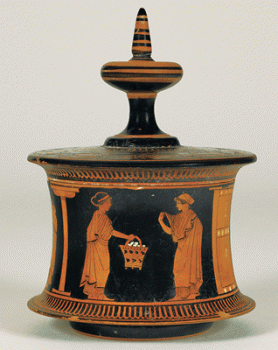American Journal of Archaeology | The Journal of the Archaeological Institute of America
You are here
Legendary Women and Greek Womanhood: The Heroines Pyxis in the British Museum
July 2010 (114.3)
Legendary Women and Greek Womanhood: The Heroines Pyxis in the British Museum
The Heroines pyxis in the British Museum is a fifth-century B.C.E. Attic red-figure vase that is attributed to a follower of Douris and appears at first glance to depict a generic scene of women’s life. The scene, however, is transformed by the artist’s use of inscriptions that give the names of mythological heroines to almost all the figures: Helen, Klytaimnestra, Kassandra, Iphigeneia, and Danae. Scholars have found the subject difficult to interpret because these women do not appear together in any one known story. This article argues that the vase painter meaningfully paired the women to prompt viewers to compare and contrast them in the same way that the tradition of Greek catalogue poetry does. The inscriptions name legendary women who would have evoked stories that reflect a range of ideals and ideas about Greek womanhood. The heroines resonate with one another in deliberate juxtapositions, articulating paradigms of womanhood that reveal the self-fashioning of contemporary aristocratic Athenian women. The pyxis expands our way of looking at Greek vases by suggesting that the inscriptions are not mere labels that clarify a scene, but cues that can create layers of complexity and meaning.
Legendary Women and Greek Womanhood: The Heroines Pyxis in the British Museum
By Anthony F. Mangieri
American Journal of Archaeology Vol. 114, No. 3 (July 2010), pp. 403–428
DOI: 10.3764/aja.114.3.429
© 2010 Archaeological Institute of America


